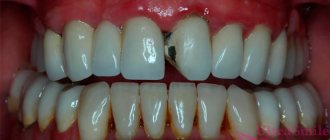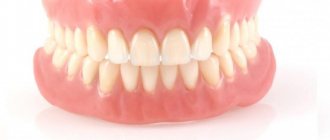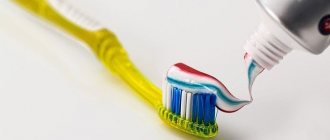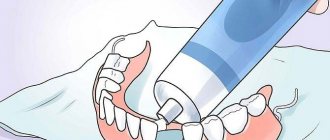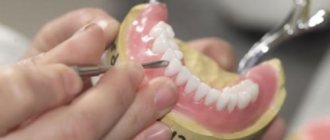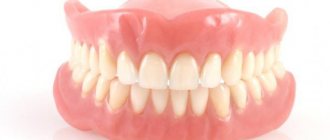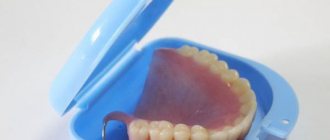The most common service in dentistry is prosthetics. If the dentist performs it correctly, a person’s teeth will become straight and their smile will be attractive. Since a large load is created on the jaw during chewing, situations may occur in which structural elements are damaged. You need to figure out how to fix a denture at home without resorting to the services of a dentist.
When to repair a structure
The materials in dentures are highly durable, but over time they can wear out or even break. Many people who use a prosthesis every day experience damage that requires emergency repairs.
There are the following reasons why device correction may be required:
- the crowns acquire a defective shade, for example, yellow or brown;
- the appearance of discomfort, pain, which previously did not bother the patient when using the structure;
- detachment, crack, puncture, peeling or other defects causing discomfort or loss of function;
- mechanical damage when clenching teeth, chewing hard elements.
If a breakdown occurs, it is better to contact your dentist directly so that he can repair the product without causing further defects. But there are times when immediate contact with a specialist is impossible. For example, if a person is away. Then temporary repairs can be done at home.
It is important not to damage the structure yourself, since repairing it will cost much less than buying a new prosthesis. There may also be breakdowns that a person cannot handle, for example, if repairs require the use of specific medical instruments.
Problem No. 3: the removable denture has failed
Nature of defects
Removable dentures also have crowns that imitate natural teeth. They are, as a rule, made of lightweight plastic, which wears out quite quickly, chips from excessive stress, and accumulates plaque and dyes. Sometimes artificial crowns fall out of their bed, which is also a problem.
If the structure is only partially removable and is attached to the teeth remaining in the mouth using special hooks and clasps, then it is possible that the fasteners may bend, break or fail.
Another problem is that the prosthesis has become deformed, its shape has changed, the quality of its fit to the gums has changed, and it falls out of the mouth.
Often, cracks and breaks appear right at the base of such products. Naturally, most often due to inadequate load on the structure, overload of its individual areas, or consumption of solid food “beyond their control.” And also when falling from a height onto hard surfaces. Is it possible to repair removable dentures in this case? Here everything depends not only on the nature of the breakdown, but also on the material from which the device is made.
Dentures may break
On a note!
At the stage of adaptation to removable dentures and during their further use, many patients experience discomfort and think that the structures are broken. However, in reality this turns out not to be the case. It’s just that removable appliances have a number of features that you need to be prepared for from the very beginning: they can put pressure and rub the mucous membrane, under load they can stretch and deform, and without frequent corrections and adjustments by an orthopedic dentist, they begin to shift and fall out of the mouth.
How the problem is solved
With denture crowns, everything is simple: chips and cracks are repaired with a composite, fallen artificial teeth are soldered onto a bed designed for them. Doctors are also able to straighten, replace and re-solder hooks for partially removable devices if they are broken. But only on the condition that the supporting teeth are intact and can all also take on increased load. If the “supports” are destroyed, then another prosthesis must be made for a new clinical situation.
What if there is a crack in the base of the structure? This happens quite often, because removable products do not adhere well to the mucous membrane, cannot evenly distribute the chewing load, and over time begin to shift, become deformed and break.
It is most realistic to repair acrylic dentures, as well as models made from soft plastic. To repair cracks and breaks in them and restore integrity, doctors first process the broken edges with special cutters, then carefully align and glue them together, apply plastic to the joints and polymerize them using a special lamp. Then the product is ground and thoroughly polished.
Some dentures can be repaired
But if a break appears in a nylon structure, then orthopedists and technicians, as a rule, will not be able to do anything. If a naturally elastic material does break (this happens rarely; more often it stretches), it can no longer be repaired.
If there is a serious fracture at the base of the product, repairing a removable denture is almost impossible.
If the structures become mobile, shift and fall out of your mouth, then you are unlikely to need repair of removable dentures. In such a situation, it is necessary to visit an orthopedist who will reposition, correct, sharpen and adjust the products to the characteristics of the alveolar ridge, the volume and relief of which changes (decreases) over time. Do not forget that jawbone atrophy occurs under removable appliances.
Damaging factors
The use of dentures is very convenient for people who have lost part of their teeth or the entire dentition. This is a life-saving design, thanks to which the chewing function is fully restored. If it is installed in a timely manner, there will be no defect in the soft tissues or jaw bones. After installation, the dentist warns about the following features:
- rules of daily care;
- possible types of defects for which you will need to seek help from a dentist;
- rules for installing and removing the structure.
A small defect or complete breakdown of a denture can happen at the most inopportune moment. this :
- end of service life;
- impact on various objects, hard surfaces, which occurs when removing or installing a prosthesis;
- improper manufacturing of the system, use of low-quality materials;
- the appearance of bubbles that remain between the prosthesis and the person’s own tissues makes it difficult to use the prosthesis.
If a denture breaks, the patient may not notice it and will continue to use it. This may lead to the following consequences:
- damage to a person’s own tissues, for example, if a chip appears on the prosthesis;
- worsening defects on the prosthesis, for example, a small crack can lead to a complete split of the structure.
Both part of the structure and the entire product may break. It all depends on the extent of the damage. It is necessary to quickly make a decision on the repair method in order to prevent complications and maintain the integrity of the structure.
Rating of the best products and rules for choosing a cream for removable dentures
Fixation of the prosthesis
Why do we need fixing agents for dentures?
A cream for fixing dentures gives a person the opportunity to strengthen the adhesion of the structure to the soft tissues of the oral cavity, without visiting a specialist’s office. For a certain category of patients, mainly for those who use complete removable solutions, the use of such fixing agents becomes a standard and integral procedure.
Dentures in the mouth
According to numerous patient reviews, denture creams help speed up and significantly facilitate the process of adaptation to a new design. Thus, during habituation, fixing agents allow:
- eat food without feeling discomfort in the mouth,
- preserve speech function,
- do not experience psychological discomfort during a conversation.
Almost every drug contains mint extracts. Therefore, such products also have a pleasant, refreshing taste and smell.
Composition of fixing creams
Often, preparations for fixing dentures include organic compounds of plant or animal origin. In addition, such products may contain flavoring and aromatic components that can reduce discomfort during the adaptation period, as well as freshen breath.
On modern pharmacy counters there are many products created on the basis of zinc. When combined with other components, this substance gives an excellent anti-inflammatory effect and is capable of healing wounds. But with frequent use, zinc has a very negative effect on the body, so such creams should be used only periodically, i.e.
i.e. within reasonable limits.
Areas of application of denture creams
Creams are used only if there are removable structures in the oral cavity. And, as a rule, designed for completely edentulous teeth. Since partial structures are often attached to supporting teeth, there is no point in fixing them.
To a greater extent, plate and acrylic dentures made of hard plastics, as well as structures made of nylon, require additional fastening, especially after 2-3 years of active wear (they stretch and are poorly fixed in the mouth).
Stretching dentures
What is the difference between glue, gel and cream?
Today, manufacturers of fixing products for prostheses offer a wide range of various gels, creams and adhesives. But which of the proposed drugs is better to choose? It is not easy to give an exact answer to this question, because the choice of specific products largely depends on the individual situation, so you should first consult with your dentist.
For example, K. Fredrickson, professor of the dental department of the Faculty of Medicine at the University of Leuven, who specializes in studying the types of prostheses and their prevalence among the population, claims that all fixing compositions are practically the same in terms of application and functionality.
The main difference in this case is the degree of viscosity and thickness. For example, the cream has a higher density and is ideal for beginners. With the gel there may be minor difficulties in determining the correct dosage.
As for the glue, the more liquid it is, the more it will be needed to securely fix the structure in the mouth.
Review of the best products
- “Corega for cleaning dentures”: perhaps the most popular product in the rating for fixing orthopedic structures. The drug is easy to use and affordable. However, “Korega” also has very significant disadvantages, including short fixation of only up to 3 hours, as well as rapid washout with water. In some cases, the product may cause discomfort if it enters the stomach. The price for it varies from 190 to 300 rubles per tube,
Fixing cream "Korega"
“About six months ago I tried Corega for the first time. To be honest, after using this product I was left with conflicting impressions. The prosthesis holds well, but only in the first 4-5 hours. After this, the product must be reapplied. For me personally, after this time, a specific gap forms between the artificial gum and my own. In addition, the gel needs to be applied to a dry surface, and I don’t always have enough time at my disposal to carry out all the necessary procedures. And the consumption is impressive - my tube disappears in two weeks. Regarding the advantages, I can say one thing with confidence: after a few days, the irritation and inflammation on the gums subsided.”
Kirill, 45 years old, Moscow, review from otzovik.com
- "Fittydent" (Fittydent): one of the best fixing drugs, however, some patients report tingling and burning when using this product. To minimize the risk of developing such side effects, it is important to strictly follow the instructions for using the fixation cream. After applying the composition to the surface of the product, you must wait half a minute until it dries completely. The cost varies from 190 to 250 rubles,
Fixing cream "Fittident" - President: the product provides a dense and at the same time elastic layer, however, the effect of the drug is significantly weakened when eating liquid hot food. Contains petroleum jelly and flavorings. The price of the cream is 200-300 rubles,
President Fixing Cream - Rocs: a product jointly produced by Russian and Swiss companies, provides up to 12 hours of reliable retention of the prosthesis in the oral cavity. This is a fairly strong product that is easy to apply, guarantees tightness, and eliminates any possibility of food residues and microbes getting under the parts of the product. At the same time, hot drinks and food do not have any effect on the effectiveness of the cream used to fix the denture. The average cost is 250-400 rubles,
Fixing cream Rocs - Lacalut Dent: a German-made product characterized by the highest levels of effectiveness and a guarantee of fixation for up to 24 hours. This extra strong remedy has proven itself well during the adaptation period. Additionally, the drug provides reliable protection of soft tissues from injury from sharp parts of the structure. The cost varies from 250 to 400 rubles per tube,
Fixation cream Lacalut Dent - “Protefix”: the cream guarantees strong fastening of the prosthesis for up to 10-12 hours. For patients prone to allergic reactions, the manufacturer offers an option without fragrances and dyes. The range also includes products with a refreshing effect and an anti-inflammatory gel with aloe extract. The cost of the drug varies from 150 to 400 rubles.
Fixing cream "Protefix"
Safety of use
When answering the question whether a cream for fixing dentures is harmful, it should be noted that this is a unique combination of numerous chemical compounds, and some of them cannot be called completely harmless to the human body. During use, the drug inevitably enters the stomach, and therefore in some cases can lead to the development of the following reactions:
- vomiting, nausea, stomach pain,
- taste disturbances,
- headache,
- increased salivation.
Adverse reactions
Indications and contraindications
Thus, the drugs under consideration to improve the fixation of orthopedic structures are used in the following cases:
- to securely hold the prosthesis in the oral cavity during chewing and speaking, in order to eliminate the psychological discomfort associated with the fear of the “false jaw” falling out at the most inopportune moment,
- increased requirements for appearance and diction associated with the patient’s professional activities,
- increased dryness in the mouth due to any disease or after taking certain medications, especially in elderly patients.
Recovery Features
Many people are afraid to go to the dentist when defects appear, because they believe that repairs will be expensive. But it is better to repair a small defect in a timely manner than to completely replace the structure. Features of the restoration of the product depend on the cause of the damage and the degree of development of the defects. The recovery method takes place in stages:
- Removal and inspection of the structure
. If there are particles of dirt on the surface, the structure is completely cleaned. - Uses of Dental Resin
. Damaged particles stick together to create a sealed state. You can achieve an appearance that does not differ from the original quality. - Evaluation of the shade of the structure
. Its color is affected by drinking caffeine and strong tea, and smoking cigarettes. If contamination is detected, the surface must be cleaned. This should only be done by a dentist using specialized medical solutions. He will achieve the original, ideal shade of the crowns. - Chips of a small part or the entire crown
. There is no need to worry about this; even if a large part of the column breaks off, it can be restored. For this purpose, they turn to a dental technician to strengthen the broken product into place.
If a piece breaks off from a denture, you should not throw it away. Together with him, they contact a dentist or dental technician, he will help restore the integrity of the structure.
Bonding materials
In the process of creating a crown, only materials with a high degree of strength are used. But even in this case, small chips and cracks are possible. You can eliminate them yourself. But it is important to understand that home renovations are only a temporary measure. As soon as the patient has the time and opportunity, he should see a dentist.
If repairs are initially carried out at home, dentists give the following recommendations:
- Preheat the device to allow the wax to melt. This technique is typical only for removable structures, so as not to damage a person’s own tissue.
- Giving the correct shape to the gypsum base. It should be cone-shaped. To change the shape, the prosthesis is repeatedly exposed to heat.
- When the device has cooled, the gluing area is treated with sandpaper so that there are no rusty particles left on the surface that scratch the gums.
- Fastening the fallen part of the crown to the structure. It is important to place it in the exact location, not to mix it up, otherwise severe discomfort will occur.
- Bonding the crowns and the base of the structure using wax or other auxiliary material. The glue must be reliable, but safe, it must not damage the device.
- Wait for the structure to dry and cool. The adhesive substance should not get on the soft tissues in the person’s mouth. The remaining excess wax that has spread around the edges is removed.
Bonding may require more than just wax. To achieve a more stable fixation, it is recommended to purchase special glue from a dental store. It is intended specifically for dentures. Once glued, the device can be reused, but it is important to understand that this will not last long. The structure glued in this way can be damaged again, so it is important to consult a doctor in a timely manner. It is unacceptable to further damage the system during repairs, otherwise restoration of integrity by the dentist may not occur.
Relining the prosthesis
There is another type of denture repair called relining. It is required when more than a year or two has passed since the manufacture of the prosthesis or when the patient’s conditions in the mouth are very poor (with severe atrophy of the alveolar process).
Relining the prosthesis is done in two ways:
- directly in the patient’s mouth in the dental office;
- on dentures in a dental laboratory.
In the first case, the orthopedic dentist places a special plastic on the inside of the prosthesis and immediately presses it to the patient’s mouth. Excess plastic is removed from the outer part of the prosthesis, and its edges are smoothed with rubber bands. The relocation is ready.
The option of relining the prosthesis in the laboratory takes a little longer. The dental technician makes a plaster model of the patient’s prosthesis, coats it with an insulating varnish, applies diluted cold polymerization plastic to the inside of the prosthesis and places the prosthesis on the model, pressing it. After the required period of polymerization of the plastic, its excess is removed, the edges of the prosthesis are smoothed with rubber bands and polished with felts. The work is transferred to the orthopedic dentist for fitting it into the patient’s oral cavity.
Removable denture repair
To carry out the repair procedure yourself requires skill and a little experience. The patient must decide whether he can eliminate the defect on his own, or whether it is better to go straight to the dentist. There are certain risks in the process of such actions:
- greater damage to the device;
- improper repair leading to malocclusion;
- the presence of chips and rough surfaces that cause damage to adjacent soft tissues.
If you repair the product yourself, you may not be able to fully restore its functionality.
If you contact a professional dentist and dental technician in a timely manner, the product can be completely repaired in a few days and its functions will be restored. The integrity of the structure is restored in full. To do this, dentists follow step-by-step instructions in restoring the integrity of the prosthesis using medical equipment.
Repair instructions for plate dentures:
- Detection of a defect, application of the damaged structure to the location. Fixation is carried out using sticky wax or medical glue.
- Application of an insulating agent. It is installed from the side of the prosthetic bed. This prevents the plastic structure and plaster from sticking together. You cannot do this with your hands; use a brush or brush.
- Formation of a fixing model from plaster. Only top class materials are used. The denture needs to be divided and the fracture lines processed with a micromotor or cutter. Individual parts of the structure are installed using a fixing model. The dentist ensures that the distance between the fixation models in the area of the fracture does not exceed 3 mm.
- Forming a fold. The bevel angle should be 45° in relation to the base of the device. This will create a smooth transition between the old and new areas of plastic. They will be connected in a better shape.
- Application of an insulating agent. It is used on the surface of plaster so that the adhesive material does not absorb liquids spreading from plastics. Otherwise, large pores will form. As soon as the parts of the prosthesis have been fixed with monomer, they begin to knead the plastic. This action occurs in stages.
- The plastic prepared according to plan should swell. It is transferred to the prosthetic areas with a reserve. Then press a little with your fingers. The resulting product is transferred to the apparatus to polymerize the plastic.
At the final stage, excess plastic must be removed. For this purpose, a micromotor and a press are used. The surface is leveled with medical instruments intended for grinding. After polishing the surface, the product is treated with antiseptic solutions. It is ready to use.
Fixation of dentures: methods and convenience
The convenience of using a denture largely depends on correct fixation.
To achieve this, orthodontists try to achieve maximum compliance of the inner surface of the prosthesis with the shape of the patient’s alveolar process. As a rule, such structures usually have special fixing elements. However, they cope with the problem of fixing the prosthesis at rest. But when chewing or talking, the structure may fail due to increased load. Therefore, for better fixation of such devices, special means are used.
Depending on how many teeth a person is missing, doctors recommend the installation of full or partial dental restorations. Removable structures are mainly made of plastic in combination with other materials. Each type of such devices has its own characteristics of fixation. In addition to clasps (or brackets) and attachments (clasps), special means are used to secure dental structures, presented in the form of:
- cream or gel;
- glue;
- stripes;
- powder.
Fixatives are usually made from plant or animal products. They are saturated with saliva and increase in volume, forming a layer between the plastic base and the mucous membrane that provides high adhesion force for the prosthesis.
Also, fixation means prevent food debris from getting under the prosthesis, and also facilitate the process of adaptation to the prosthesis and tissue healing after its installation.
Recovery technique in the clinic
At the dental clinic, the doctor initially examines the device visually. It should be examined by a dental technician. If pieces of food and other foreign objects are stuck in the denture, pre-clean it. Only after this can you accurately see all the defects and begin the restoration of the structure. If you exclude the cleaning step, the adhesive will not be able to completely fix the broken product. Then the repair procedure will be ineffective. Only after cleaning can high-quality sealing be achieved.
If the defects in the device are excessively large, the dentist will recommend completely replacing the structure. This is due to the following features:
- saving money, since repairs may require similar financial resources as major repairs;
- the possibility of a lack of quality effect during repairs; the base will continue to break, damage tissues, and disrupt the bite.
Only if minor chips or cracks appear on the prosthesis, it can be restored. For example, if a small chip occurs on the crowns, remove the device and fix it. Why install the crown in place? The result should be a product that is not inferior in function to new prostheses.
Many patients believe that they can handle the repair themselves. But there is a big difference between home bonding and professional services. At home, you can make a little adjustment to the design before going to the dentist. Complete repairs can only be carried out by a competent dental technician. He must have specialized tools at hand in order to carry out high-quality restoration.
The patient does not have solutions or tools at home that will return the whiteness to the crowns on the prosthesis. Periodically, it is necessary to restore the shade in order for the prosthesis to perform an aesthetic function. It should completely replace the appearance of real teeth.
It is not always possible to achieve high-quality restoration after repair, even from a dentist. For example, if a stamped device or a product without metal is damaged, it cannot be repaired.
Repair price
The cost of restoring the quality of a denture after repair depends on the following factors:
- the complexity of the work performed by a dental technician;
- product material;
- area and degree of damage.
For example, if a patient’s metal-ceramic structure is slightly broken, repairs can reach up to 2,000 rubles.
The following approximate price list is highlighted:
- installation of a new artificial crown - 2500 rubles;
- professional cleaning and whitening of crowns, basics of the device - 1000 rubles;
- restoration of crown shade when drinking coffee, after prolonged smoking - 1200 rubles.
If you carry out the restoration yourself, the price will be significantly lower, but the entire structure will not be able to regain its original appearance. The damage may recur or continue to get worse.
